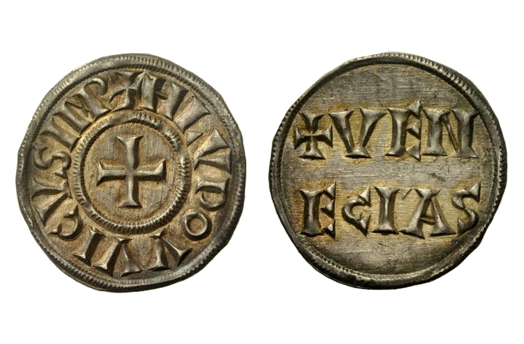
about ancient nomos
Ancient Nomos Art is a museum of galleries exhibiting ancient coins and ancient mint maps. The coin gallery displays the diverse art and history of hand-crafted ancient Greek, Roman, Byzantine, Persian and Medieval coinage. The ancient mints mapping gallery features Greek, Roman, Byzantine, Asia Minor and Medieval mint city regions and territories. Visitor's are welcome to explore, study and enjoy Ancient Nomos Art.

Medieval, Venice – 814 AD
Louis I 'le Pieux'
From Ancient Galleries

Obverse: +HLVDOVVICVS IMP legend as Emperor Louis I; small cross pattée in center.
Reverse: Venice mint VEN/ECIAS in two lines across field; small cross before legend.
LEGEND
Obv: Carolingian Emperor Louis the Pious legend: +HLVDOVVICVS IMP, with small cross pattée in center. Rev: Venice mint legend: +VEN/ECIAS in two lines across field.
The above coin represents the earliest of Carolingian coinage minted in Venice, Italy. It was minted under the authority of King Louis “le Pious” of West Francia. Louis was the son and successor to King Charlemagne of Francia. Prior to this Carolingian issue, the city of Venice was not authorized by Byzantium to produce medieval coinage. Coins for the Byzantine north Italy were minted in Ravenna, until the city lost its the status as a Holy Roman capital city. Ravenna lost capital status during the advancements of Charlemagne and from the dissolution of the Exarchate. Prior to the dissolution, Ravenna was the main coin production mint in northern Italy. Following these events, the Carolingian Empire seized opportunities to facilitate trade and commerce with the east by establishing a permanent port in the city of Venice. Earlier attempts by the Carolingian empire to forcibly subjugate a Venetian port of entry did not succeed. However, during the Pax Nicephori or Peace Treaty of Aachen, Byzantium agreed to allowed Venice complete territorial independence, provided Byzantium could control the entire province of Venezia. The new Venetian independence allowed the city to establish trading rights with Louis the Pious. This gave Louis and his empire an eastern port city for its mercantile trade and commerce, in 812 AD. A Venice port would greatly facilitate Carolingian trade with its northern territories of central Europe. As a consequence, Venice became an important mint city for striking Louis the Pious Carolingian coinage. The above coin is dated to 817 – 822 AD. At this time, the Venice mint adopted a new monetary system based on Carolingian silver denominations, where 240 denier was equal to 20 gold solidi. The above silver denier was issued during the first year of Louis’ reign. The coins obverse legend names the Holy Roman Emperor with the name “LVDOVVICVS” (Louis I the Pious). The coins reverse indicates the coin was struck in Venice, as the legend “VENECIAS” reveals in two separate lines. The fact that Louis I was able to mint coins across all of Europe, which rapidly circulated across all of France to the Italy, including the port city of Venice, is a numismatic testament to his strong rule, unification of the imperial economy, and a prosperous Carolingian centralized economy.
DOCUMENTATION
Value: Denier. Metal: AR Silver. Weight: 1.80 grams. Mint: Venice. Date: 814-822 AD.
Attribution: Coupland, Money Class II; Depeyrot 1116D; Morrison/Grunthal 456; MEC 1, 789.
Legend, Documentation and Attribution
